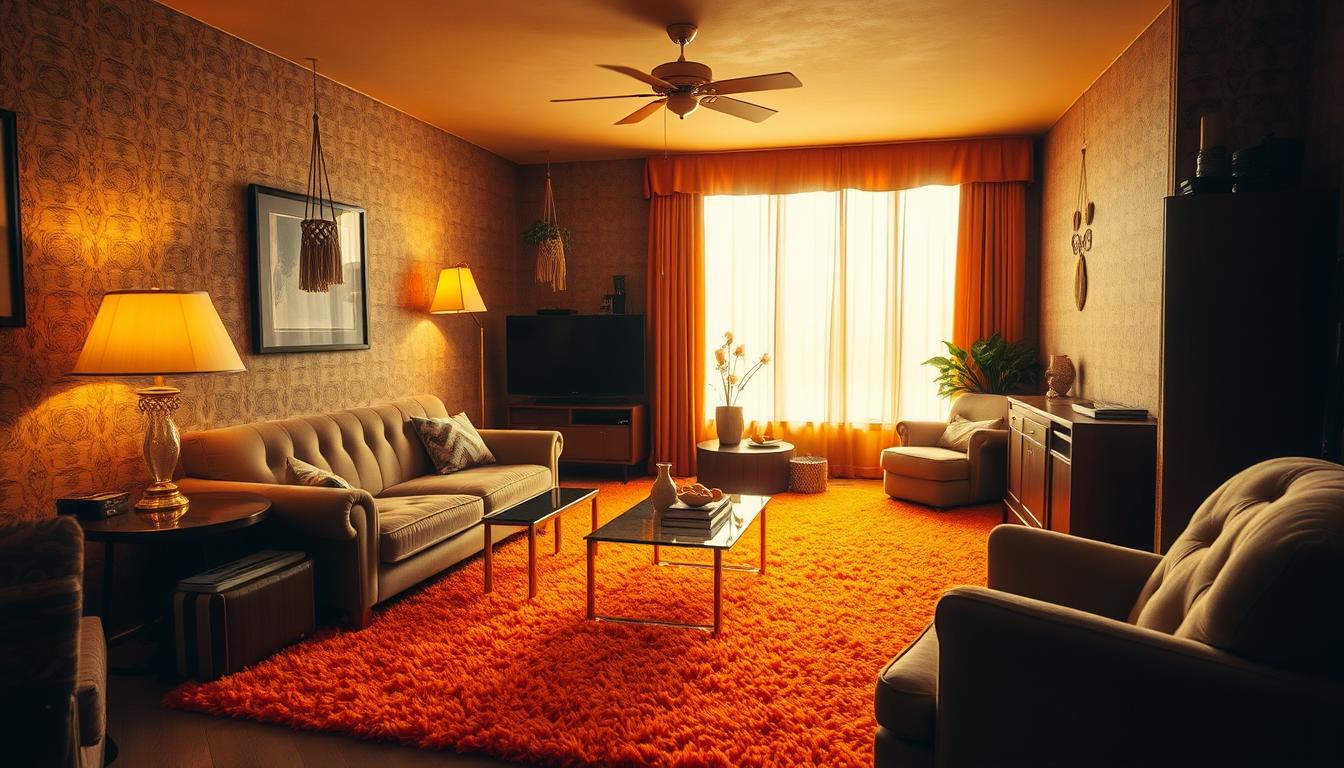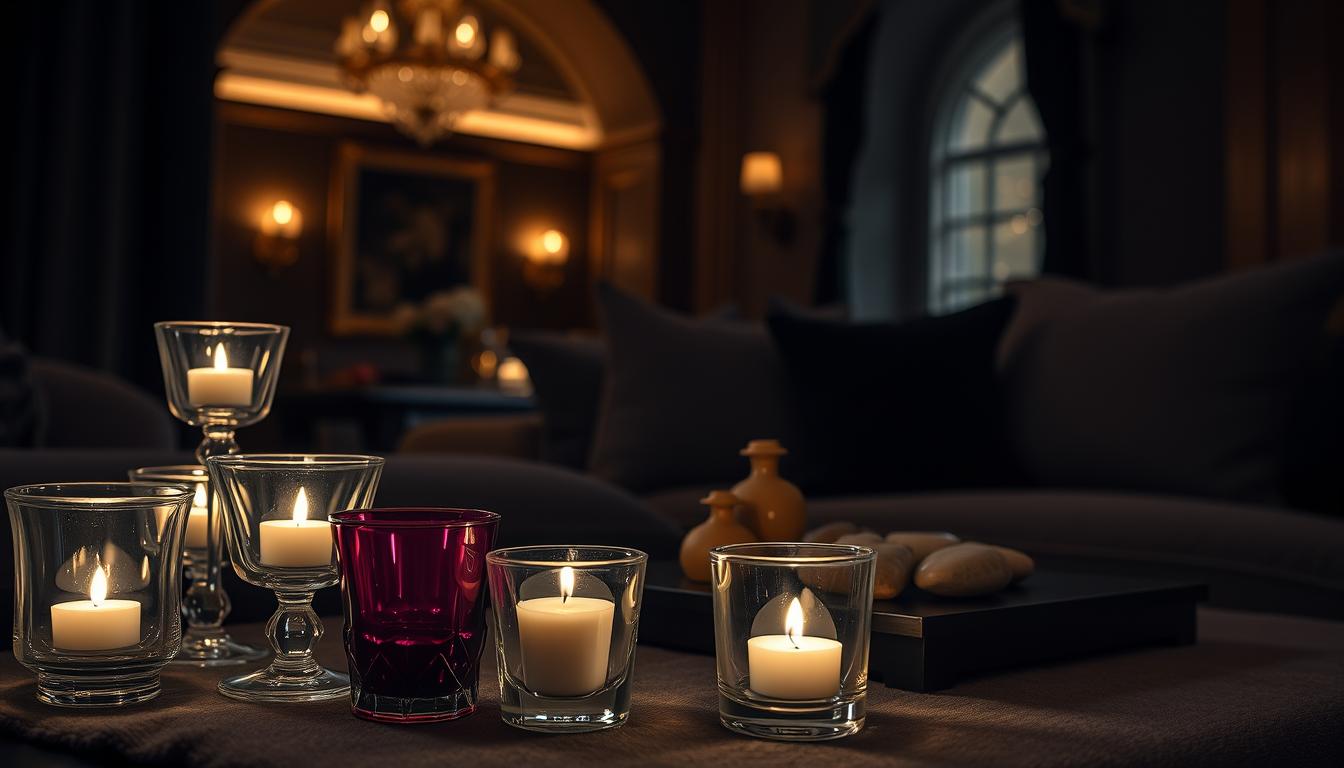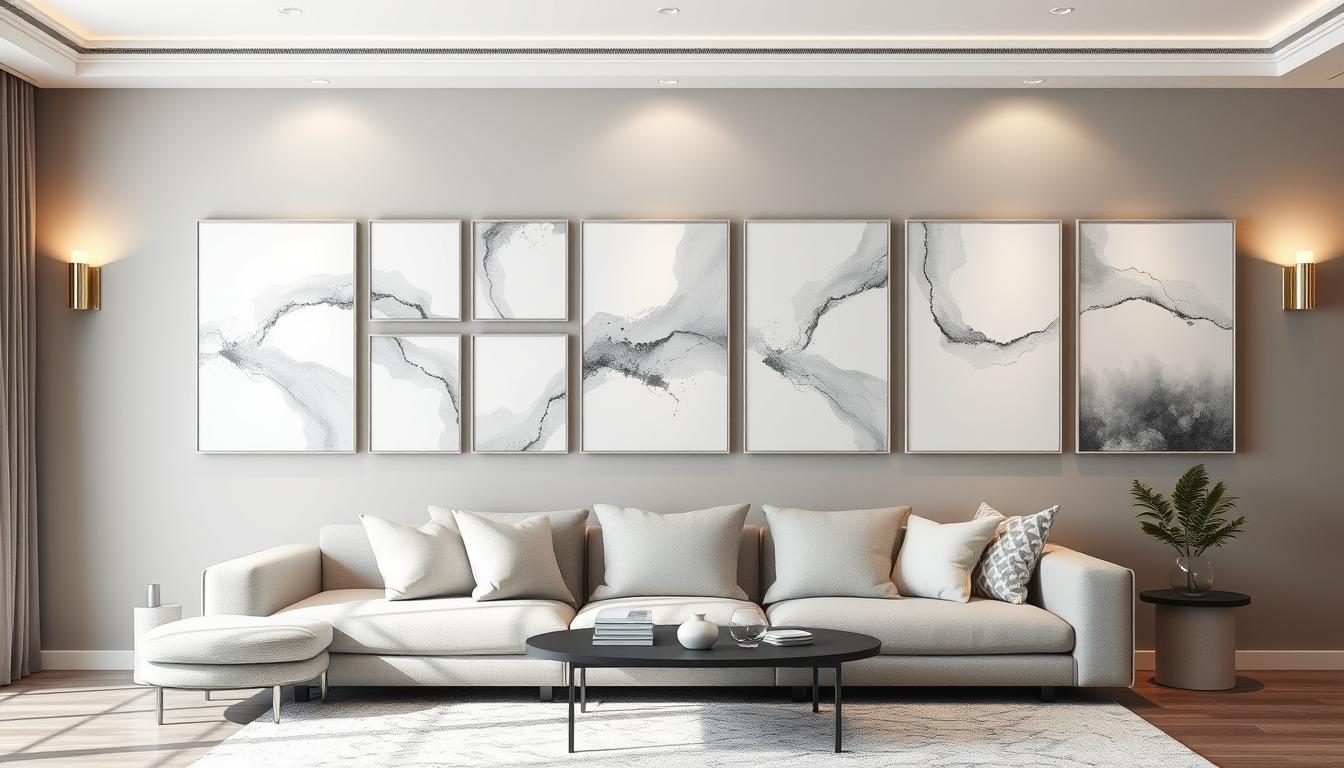The 1970s was a decade of bold expression. This was seen in retro interior design. It featured vibrant colors, unique patterns, and eclectic decor. These elements still inspire modern interior design today.
We’re excited to take you on a journey through the groovy world of retro interior design. We’ll explore key elements that define this iconic style. From retro furniture to vintage decor, we’ll look at the characteristics of 70s design and its impact on today’s styling.
Key Takeaways
- Understanding the core elements of 70s retro interior design
- How to incorporate vintage decor into modern spaces
- The role of bold colors and patterns in 70s home styling
- Tips for balancing retro and contemporary design elements
- Exploring the influence of popular culture on 70s interior design
Understanding the 70s Aesthetic
The 1970s celebrated self-expression, showing in its home decor. This era’s design was bold and eclectic, making each home unique. It showed the owner’s personality.
Key Characteristics of 70s Design
The 1970s design was known for bold colors and funky patterns. Colors like avocado green and burnt orange were popular. Geometric prints and shag rugs added to the lively feel of homes.
Eclectic decor was also big in the 1970s. People mixed different textures and objects in their homes. This mix showed the cultural and social changes of the time.
Popular Colors and Patterns
The 1970s had a wide range of colors, from earthy to bright. Some iconic colors include:
| Color | Description | Common Uses |
|---|---|---|
| Avocado Green | A muted, greenish-yellow hue | Kitchen appliances, wall paint |
| Burnt Orange | A vibrant, reddish-orange color | Accent walls, decorative accessories |
| Harvest Gold | A warm, golden yellow color | Bathroom fixtures, kitchen decor |
The Influence of Popular Culture
Popular culture shaped the 1970s interior design. The music scene, with disco and rock, added flashy elements. Films and TV shows also inspired retro-futuristic and bohemian designs.
The 1970s’ culture had a big impact on home decor. By embracing these styles, homeowners made spaces that showed their personalities and interests.
Iconic Furniture Styles of the 70s
The 1970s left a lasting mark on home decor. This decade saw a move towards casual, relaxed living. This change was mirrored in the furniture of the time.
The Rise of Modular Furniture
Modular furniture became a big deal in the 1970s. It let people change their living spaces easily. This was perfect for creating cozy, adaptable areas for different activities.
Modular furniture offered many benefits:
- It was flexible and easy to change up.
- It fit well with different room layouts.
- It encouraged people to come together and socialize.
Bean Bags and Retro Sofas
Bean bags and retro sofas were key in 1970s living rooms. They were comfy and added a fun vibe to decor. Bean bags, in particular, symbolized the laid-back 1970s lifestyle.
Bean bags and retro sofas were loved for their comfort and flexibility. They were great for casual spots like family rooms or game rooms. They were a top pick for comfy seating.
Natural Materials in Furniture
The 1970s also saw a big push for furniture made from natural materials. Wood, wicker, and rattan were favorites. They added warmth and elegance to homes.
Some top natural materials in 1970s furniture were:
- Rattan
- Wicker
- Reclaimed wood
Using these materials helped create cozy, inviting homes. It showed the era’s focus on comfort and being green.
Essential Color Palettes
The 1970s were all about bold colors in home decor. These colors still inspire us today. They helped shape the look of homes back then.
Earth Tones and Vibrant Accents
Earth tones like terracotta, sienna, and moss green were big in the 1970s. They were mixed with bright colors like turquoise, orange, and yellow. This mix made rooms lively and full of life.
Using Neutrals with Bold Colors
To balance the bold colors, neutrals like beige, cream, and white were used. They provided a calm background. This made it easy to add bold pieces without feeling too much.
The Impact of Pastels
Pastel colors were also big in the 1970s. They brought softness and fun to rooms. Soft pink, baby blue, and mint green were favorites, often paired with brighter colors for a unique look.
| Color Palette | Characteristics | Example Colors |
|---|---|---|
| Earth Tones | Natural, warm, and inviting | Terracotta, Sienna, Moss Green |
| Vibrant Accents | Bold, playful, and energetic | Turquoise, Orange, Yellow |
| Pastel Hues | Soft, whimsical, and delicate | Soft Pink, Baby Blue, Mint Green |
By using these color palettes, you can bring the 1970s vibe into your home. It’s a fun way to add some retro charm.
Flooring Trends of the 70s
The 1970s saw a big change in flooring. People started using new materials, textures, and patterns. These added warmth and character to homes. Let’s explore some key flooring trends of the era.
Wall-to-Wall Carpeting
Wall-to-wall carpeting was big in the 1970s. It made rooms feel warm and cozy. The carpet came in bold colors, making a statement. It also helped divide open-plan spaces.
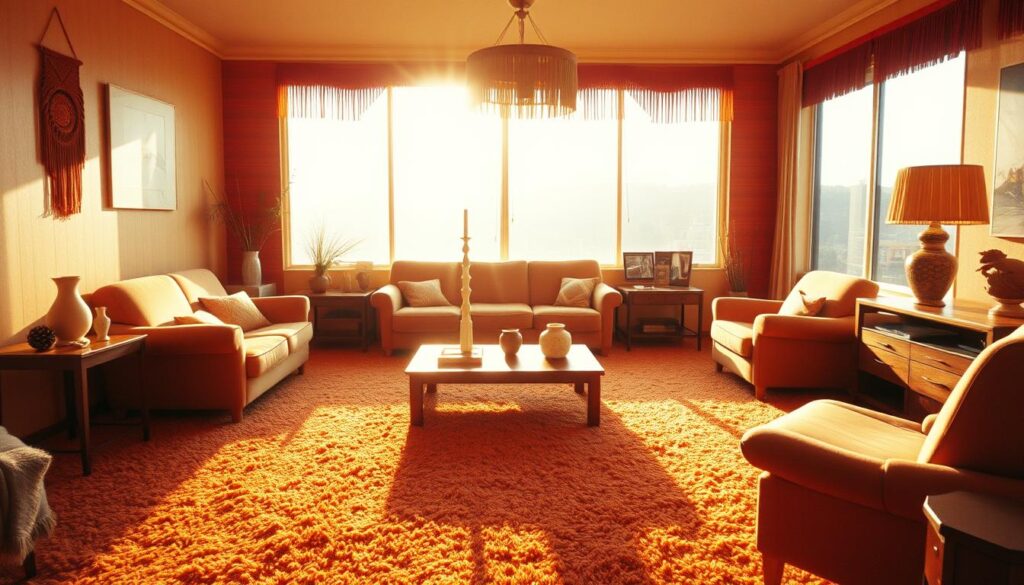
Terrazzo and Tile Designs
Terrazzo and tile designs were also popular. They were durable and versatile. Terrazzo, in particular, was loved for its unique look, made from marble or granite chips in cement.
| Material | Characteristics | Popularity in 70s |
|---|---|---|
| Wall-to-Wall Carpeting | Warmth, texture, bold colors | High |
| Terrazzo | Durable, composite appearance | Moderate |
| Tile | Versatile, easy to clean | High |
| Hardwood | Timeless, warm, natural | Increasing |
The Return of Hardwood
By the end of the 1970s, hardwood flooring was back in style. People loved its timeless beauty and warmth. This shift towards traditional materials paved the way for hardwood’s lasting popularity.
The 1970s were a time of creativity in home design. The trends from then still influence today’s retro-chic interiors. They offer a mix of style, warmth, and character.
Wall Treatments and Décor
Walls in 1970s homes were more than just space; they were a way to express oneself. The decade brought bold and innovative decorating ideas. These reflected the vibrant culture of the time.
Bold Wallpaper Ideas
Bold, vibrant wallpaper was a hallmark of 1970s decor. You’d see everything from geometric shapes to floral patterns in bright colors. These designs were not just for accent walls; they often covered entire rooms, making a bold statement.
- Geometric patterns, such as chevrons and hexagons, were very popular.
- Floral patterns, often oversized and colorful, brought a whimsical touch.
- Textured wallpapers, like grasscloth and embossed designs, added depth.
Wood Paneling Revival
Wood paneling made a big comeback in the 1970s. It brought warmth and texture to rooms. It was not just pretty; it also helped cover uneven surfaces.
Types of wood paneling:
- Pine and cedar were favorites for their natural look and smell.
- Paneling was often used on accent walls or as a feature wall.
Creative Use of Art and Accessories
The 1970s were all about eclectic decor. Art and accessories were key. Homeowners used vintage pieces, macramé, and unique items to make their spaces stand out.
Some popular art and accessory trends included:
- Macramé wall hangings and plant holders.
- Vintage posters and prints.
- Handmade crafts, showing the era’s DIY spirit.
By using these elements, homeowners could create a truly 1970s look. It was a mix of mid-century modern decor and the era’s unique style.
Lighting Styles to Consider
Lighting was key in 70s home interiors. It added warmth, character, and personality to spaces.
Lights in the 70s were more than just functional. They made a statement. Let’s look at some iconic lighting styles from the decade.
Iconic Pendant Lights
Pendant lights were everywhere in 70s homes. They came in many shapes, sizes, and materials. You could find them in glass, metal, wood, and fabric. These lights were used for both task lighting and decoration, often becoming room focal points.
Characteristics of Iconic Pendant Lights:
- Unique shapes, such as globes or sputnik designs
- Use of natural materials like wood
- Bold, vibrant colors
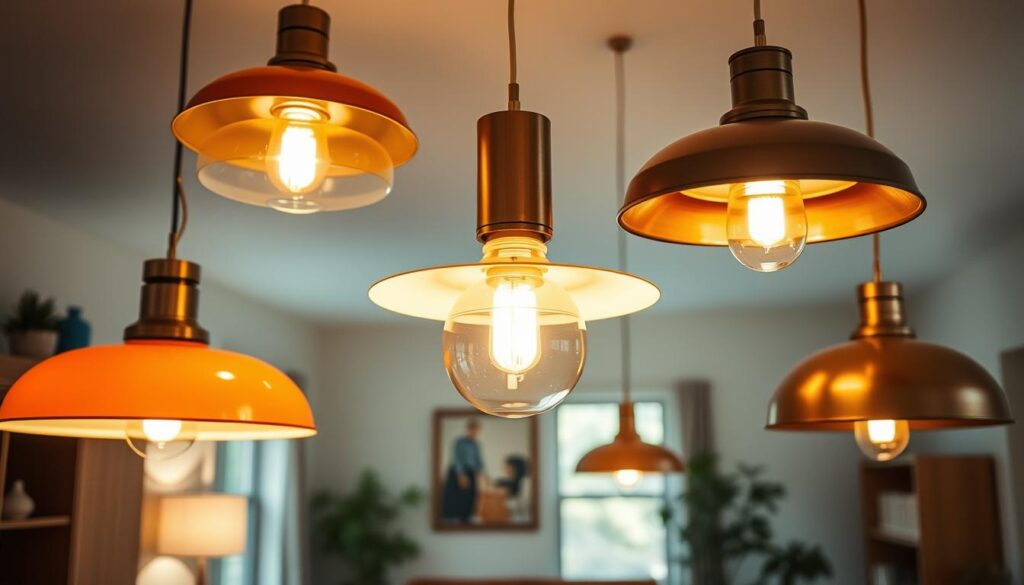
The Return of Lava Lamps
Lava lamps were a big deal in the 70s. They had a mesmerizing, flowing liquid that added whimsy and relaxation. They were both decorative and conversation starters.
“Lava lamps embody the essence of 70s decor, combining functionality with a dash of psychedelic charm.”
Floor Lamps with Flair
Floor lamps in the 70s were designed to stand out. They were tall and had elaborate designs. They provided task lighting and added to the room’s look. You could find them in sleek, modern designs or more ornate, sculptural pieces.
| Feature | Description |
|---|---|
| Design Variety | Ranged from minimalist to highly decorative |
| Materials | Often featured metal, wood, or a combination of materials |
| Functionality | Provided both task lighting and ambient lighting |
By using these iconic lighting styles, homeowners can bring 70s charm to their homes.
Textiles and Fabrics
In the 1970s, interior design was all about mixing and matching. The era’s eclectic style was reflected in its use of diverse materials and patterns. These elements added depth and character to homes.
Velvets and Corduroys
Velvet and corduroy were big in the 1970s. Velvet was luxurious and often used for upholstery. Corduroy, with its ribbed texture, was popular for clothes and home decor. These fabrics made rooms feel cozy and inviting.
Imagine a velvet sofa as the room’s centerpiece. Pair it with corduroy-covered armchairs or ottomans. This mix not only looks good but also makes the space warm and welcoming.
Geometric Prints and Textures
Geometric prints were a big deal in 1970s design. They featured bold patterns and bright colors. These prints were on fabrics like cotton, linen, and synthetic materials. They added a lively touch to rooms.
Textures were also key. Mixing different materials and weaves created depth. For example, smooth fabrics with burlap or canvas added a unique layer to a room.
“The 1970s were all about experimenting with textiles. They mixed patterns, textures, and materials for unique spaces.”
The Importance of Layering
Layering was crucial in 1970s design. Homeowners layered fabrics and materials for a rich look. This included rugs, throws, and pillows in various textures and patterns.
For a retro vibe, try layering a vintage rug over a modern one. Or drape a throw blanket with geometric print over a velvet sofa. This adds warmth and makes the space interesting.
| Fabric | Common Use | Characteristics |
|---|---|---|
| Velvet | Upholstery, Curtains | Luxurious feel, Soft glow |
| Corduroy | Upholstery, Clothing | Ribbed texture, Durable |
| Geometric Prints | Curtains, Bedding, Upholstery | Bold patterns, Vibrant colors |
For more tips on adding retro flair to your home, check out Interior Grove. They offer advice on styling small houses with a retro touch.
Integrating 70s Technology
The 1970s were a time of big tech leaps that changed homes. As we bring 1970s style into our homes, we must think about how tech shaped the era’s look.
The Retro Appeal of Vintage Electronics
Old computers, phones, and TVs are now trendy for their retro charm. They mix old-school style with today’s decor.
Displaying vintage electronics as decor or using them as functional items is a great idea. For example, an old rotary phone can be a fun phone stand.
Funky Accent Clocks and Radios
Funky clocks and radios were key in 1970s design. They had bold colors and shapes. These items bring a fun vibe to any room, capturing the 1970s spirit.
| Item | Description | Era Significance |
|---|---|---|
| Vintage Radios | Often featured bold designs and colors | Represented a new era of home entertainment |
| Accent Clocks | Geometric shapes and bright colors were common | Added a decorative touch to rooms |
Embracing the Vintage Vibe
To really bring 1970s tech into your home, go all in on the vintage vibe. Mix vintage electronics with 1970s furniture and bold colors.
This way, you’ll create a space that’s both nostalgic and modern. It honors the era’s creativity and design.
Outdoor Spaces and Gardens
The 1970s were all about embracing the outdoors. We can still capture that essence in our gardens and patios today. Outdoor spaces played a big role in the overall aesthetic of the era.
Creating a 70s Inspired Patio
To create a 1970s-inspired patio, focus on wicker furniture, colorful textiles, and natural materials. Wicker furniture adds a warm, organic feel. Pair it with vibrant textiles like macramé or embroidered fabrics to evoke the era.
Adding retro-style outdoor lighting, such as globe lights or lanterns, is key. These elements provide lighting and enhance the space’s ambiance.
Bohemian Influence in Outdoor Styling
The bohemian influence in 1970s outdoor styling was all about eclectic decor and natural elements. Homeowners used vintage planters, colorful rugs, and unique decorative pieces.
To capture this bohemian spirit, layer different textures and patterns. For example, a natural fiber rug with a vintage metal table and chairs creates a visually interesting space.
“The freedom to experiment with different styles and elements is what defined the bohemian influence in 1970s outdoor decor.”
Incorporating Nature into Design
Incorporating nature into outdoor design was key in 1970s decor. This involved using natural materials and bringing the outdoors in with plants and greenery.
Use a variety of plants with different textures and colors, like ferns, succulents, and flowering plants. Hanging baskets and planters add a vertical element to gardens and patios.
| Element | Description | Example |
|---|---|---|
| Wicker Furniture | Natural, organic feel | Wicker armchairs, sofas |
| Colorful Textiles | Vibrant patterns and colors | Macramé wall hangings, embroidered fabrics |
| Natural Materials | Earthy tones and textures | Wood, stone, bamboo |
By incorporating these elements, we can create outdoor spaces that reflect the groovy home decor of the 1970s. These spaces provide a unique and inviting area for relaxation and entertainment.
DIY Projects for a 70s Touch
DIY projects are a great way to add a 70s vibe to your home. With a few creative projects, you can make your space feel like it’s straight out of the 70s.
Upcycling Old Furniture
Upcycling old furniture is a fantastic way to get a 70s look. You can find pieces at thrift stores or in your grandparents’ attic. With a little creativity, an old dresser can become a stylish piece again.
Here are some upcycling ideas:
- Refinish wooden furniture with a natural stain to highlight the grain.
- Upholster old chairs with retro-patterned fabrics.
- Add decorative metal or wooden accents to plain furniture pieces.
Crafting Retro Décor Pieces
Making your own décor can be a fun and rewarding project. It lets you capture the essence of 70s design. You can create items that show off the era’s bold patterns and natural materials.
| Craft Project | Materials Needed | 70s Inspiration |
|---|---|---|
| Macramé Plant Hangers | Cotton rope, wooden dowel, scissors | Bohemian style, natural materials |
| Retro Wall Art | Canvas, paint, stencils | Bold patterns, vibrant colors |
| Woven Wall Hangings | Yarn, loom or cardboard frame | Textile art, handmade crafts |
Simple Ways to Add Authenticity
To make your 70s decor feel real, focus on authentic elements. Use vintage items, era-specific colors, and textures from the 70s.
Tips for Authenticity:
- Use vintage or vintage-inspired accessories like lava lamps or retro clocks.
- Incorporate natural materials such as wood, wicker, and rattan.
- Choose a color palette that reflects the earthy tones and bold accents of the 70s.
By following these DIY projects and tips, you can bring a 70s touch to your home. Your space will be both nostalgic and stylish.
Current Trends Inspired by the 70s
The 1970s are back in home decor, bringing retro-chic vibes to today’s homes. Vintage finds are being brought back to add a unique flair to modern decor.
Reviving Vintage Finds
People are mixing mid-century modern decor with modern touches in their homes. This mix of old and new looks great and is good for the planet.
Boho-Chic Fusion
The boho-chic trend is big, blending free-spirited bohemian style with chic modern pieces. It creates a stylish, eclectic space that celebrates individuality.
Sustainable Retro Design
Sustainability is key in retro design, with a focus on eco-friendly materials and repurposing old items. By embracing retro-chic, we honor the past and help the planet.

